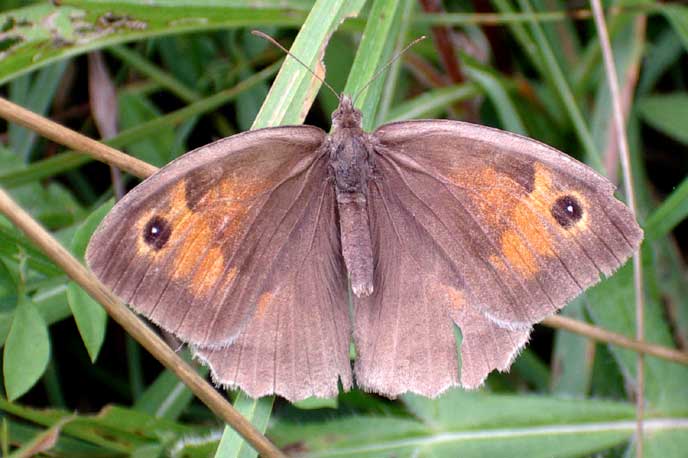 |
 |
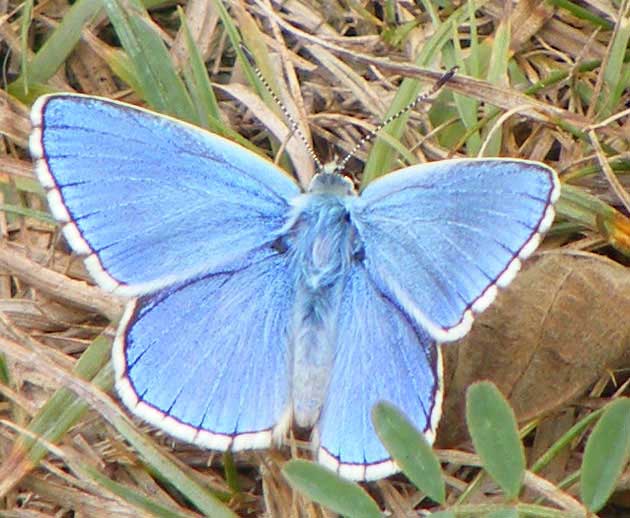 |
 |
|
|
|
|
|
 |
 |
 |
 |
|
|
|
|
|
Noticeable
summer plants of the upper meadows include Greater
Knapweed, Hardheads (=Lesser Knapweed),
Field
Scabious, Meadow Cranesbill, Alexanders,
Pyramidal
Orchids,
Plantains,
Melilots,
Meadow Vetchling, Yarrow,
Eyebrights,
Musk
Thistles,
Hounds-tongue*,
Perforate
St. John's Wort*, Great Mullein*
and many others. Herb Robert
is found amongst the scrub.
(*notably
on disturbed ground.)
Some
Indicator Plants of Ancient Downland (Link)
Wild
Flora and Fauna on Chalk flickr
Wild
Flowers 2008
| OVERVIEW:
A large part (724 acres) of the downs including Mill Hill were presented to the people of Shoreham in 1937. Just over 30 acres still remain as public open land and a Local Nature Reserve. This is divided into about 11 acres of grassland and meadows above the ridge, about 9 acres of scrub, the copse and glades at the northern end, and about half of the prime Chalkhill Blue area of 6.4 acres of herbland remaining. 6 acres has been lost to a Sycamore woodland on the southern slopes. This is low fertility chalkland not suitable for grazing. The top area is effectively a wild meadow and the lower slopes a rabbit warren dominated by prostrate (not the upright form) Horseshoe Vetch, Hippocrepis comosa. |
Horseshoe Vetch |
|||||
| Chalkhill Blues:
Mill
Hill is nationally important because of its population of Chalkhill
Blue Butterflies. Estimates of the numbers
are notoriously inaccurate. In the 1950s the population was estimated by
R. M. Craske to be 50,000. This may be an
exceptionally good year. I would estimate the numbers at that time to be
nearer 25,000 for Mill Hill only. After the cattle grazing and thorn incursions
the numbers plummeted to the most reliable estimate in 1960 of 6,000. The
new road and Sycamore woodland further denuded the Horseshoe
Vetch, Hippocrepis comosa,
and bare chalk downland to a figure I have estimated at a top figure of
3,000 Chalkhill Blue Butterflies at the turn of the millennium (counted
in 2003). Almost all these butterflies are now to be found on the six acres
of the lower slopes.
Text
by Andy Horton
|

 |
|||||
| "Our
family lived at The Mill House, Mill Hill, from around 1933 until about
1967, and every July we saw the "Butterfly Men" walking past onto
the Downs. My father used to tell us that they were interested in the blue
butterflies."
Heather
Clark (née Eager), Ryde, Isle of Wight
|
Nearest
Postcode: BN43 5FH
Grid Ref: TQ 210 074 (upper car park) Geographic Link OS Map Google Earth Map Magic Map of Mill Hill NR Local Nature Reserve Designation Natural England: Local Nature Reserves |
15
December 2008
Two
Musk
Thistles were still flowering
by the Reservoir on Mill Hill, but after the deluge or for some other reason
the prickly stems were bent and the purple flowers were drooping down.
Just a few Sow Thistles
were noted on the road edge.
| 16
November 2008
This mushroom was discovered on the edge of the meadow to the north of the upper car park on Mill Hill, believed to be the White Dapperling, Leucoagaricus leucothites. I do not think that the common name is actually used for this frequently encountered species?
|
 |
12 November 2008
It came as a great surprise to me to see a large yellow Brimstone Butterfly fly over the top meadow (north of the upper car park) on Mill Hill. It flew strongly in the direction of New Erringham. This was the first Brimstone Butterfly recorded in the month of November on these Nature Notes pages. Five minutes later a Speckled Wood Butterfly fluttered amongst the long grass south of the Reservoir on Mill Hill. On the plateau to the south of the upper car park, there were cow pats from the spring, despite the wetAugust.
2 November
2008
 |
 |
|
|
|
27
October 2008
There
were no butterflies seen in twenty minutes
before the forecasted cold weather. There
were very few nectar plants on Mill Hill, one flower
of Devil's Bit Scabious,
one Autumn
Gentian, one Stemless
Thistle, a few bedraggled Hawkbits
and some Wild Basil on
the lower slopes. A dimunitive Ragwort
was seen on the upper plateau and Musk Thistle
and Sow Thistle
on the upper part near the Reservoir.
17
October 2008
Two
Kestrels
were performing sparring acrobatics over the Copse
and scrub on Mill Hill. They were both about the same size, so I assume
that these were male birds fighting over territory. There
is usually just one male on Mill Hill seen hovering throughout the year.
A
single Musk Thistle
was still in flower by the Reservoir.
Singles of Spear Thistle
and Creeping Thistle
in flower were noted.
8 October
2008
After
five days of rain and poor weather the herb
layer of the lower slopes of Mill Hill
was still springy and firm under foot. A Peacock
Butterfly flew up and visited me. Otherwise
all the butterflies were at the northern
end and there were not very many of them, a handful of Meadow
Browns, a tatty male Adonis
Blue, at least one good condition male
Common
Blue and a Small
Copper.
 |
 |
 |
On
the top near the Reservoir, a Buff-tailed
Bumbleebee
visited a Musk Thistle
still in flower. Spear Thistles
were also still in flower and I a noted a solitary Creeping
Thistle with a full flowering head.
Adur
Butterfly List 2008
Adur
Thistles
Adur
Bumblebees
| 8
October 2008
I observed a late grasshopper on the lower slopes of Mill Hill. |
2 October
2008
There
was the faint bite of an autumn chill in the air on a morning of weak sunshine,
and the butterflies did not emerge until
near midday. At the northern end of the lower
slopes of Mill Hill, three species could be seen resting on Devil's
Bit Scabious and only later when the
sun came out did many of the butterflies emerge in numbers and fluttered
about so much that I could not be sure of their numbers.
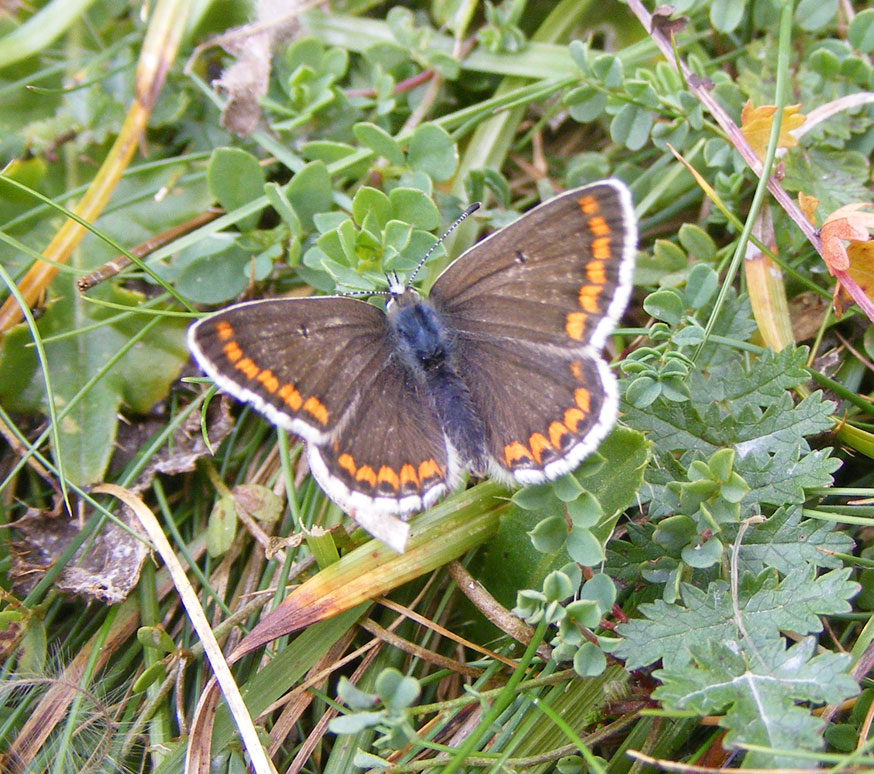 |
 |
 |
|
|
|
|
Ten
species of butterfly were recorded on Mill
Hill including Adonis Blues,
pristine Common Blues
and new Brown Argus
Butterflies emerged. The female Adonis
Blue has bars in the white outer rim of the
wing which is absent in the Common Blue
female (see the photographs above).
The numerous Autumn Gentian
on the upper plateau had ceased flowering. There were still plenty (20+)
of dried out cow pats
from the cattle grazing
in the spring.
Full
Butterfly Report
18 September 2008
People living near Shoreham's Mill Hill bridge have launched a campaign to improve safety at the notorious suicide spot.
12
September 2008
On
the lower slopes of Mill Hill, the first
butterfly seen was Common Blue,
followed later by a female of the species, a few male Adonis
Blues
scattered over the slopes with a congregation of both sexes on the Devil's
Bit Scabious at the northern end, totalling
seven males and seven females, plus six Meadow
Browns (gender undetermined, mostly males),
two Small Heath Butterflies,
at least one Treble-bar Moth
and a faded Pyrausta nigrata
moth. Three Meadow Browns
and a Common Blue
were spotted in the Old Erringham pasture in the vicinity of the stile.
Amongst the scrub, a Speckled Wood
fluttered by and two Small Heaths
were seen courting. In the top meadow there were three Common
Blue males and four more Meadow
Browns plus a surprise Wall
Brown.
9 September
2008
 |
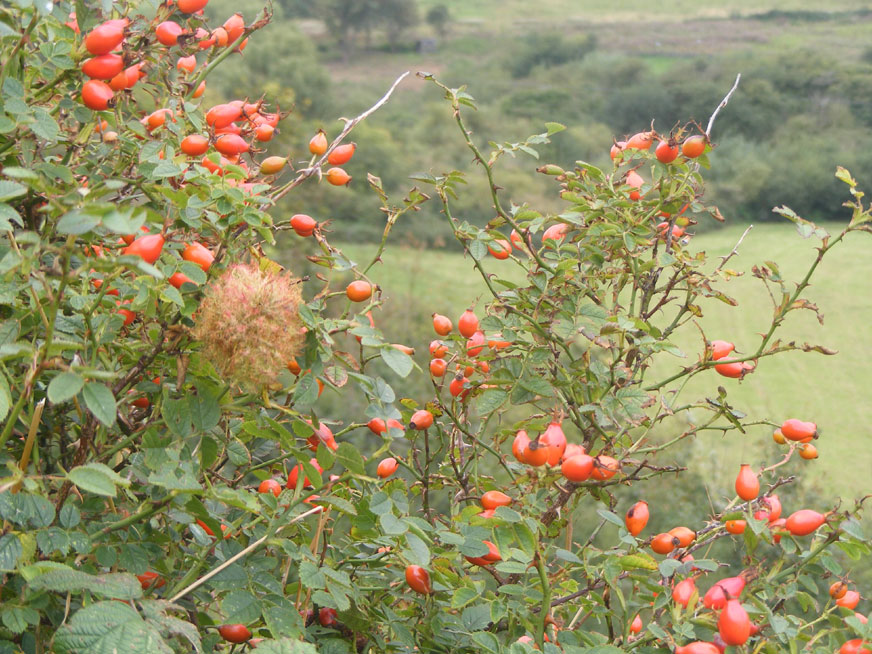 |
 |
It
was still much too overcast, with spots of rain, for butterflies
to be out and about if they had survived the atrocious weather.
A quick check on the Privet-inundated
lower
slopes of Mill Hill produced seven male Adonis
Blues, ten Meadow
Browns and a Small
Heath Butterfly. There were no Chalkhill
Blues seen. The scrub added a Speckled
Wood, and the upper area of Mill Hill
another Meadow Brown
and another Small Heath.
Devil's
Bit Scabious was seen in flower for the
first time this year. Despite four days of rain and the whole of the summer,
there were still dried-out cow pats
on the Autumn Gentian
covered plateau south of the upper car park. Most of the Autumn
Gentian was not in flower.
Adur
Butterfly List 2008
15
August 2008
After
four days of poor weather, the butterflies
were out again. They were common on the lower
slopes of Mill Hill with 25+ Chalkhill
Blues
including
a few females,
62 male Adonis Blues,
an estimated 75+
Meadow
Browns
of
both sexes, frequent
Common Blues
(estimated
12+) including very small ones, one confirmed
Gatekeeper,
a few Large Whites,
at least one Green-veined White,
two Speckled Woods on
the southern steps, and a Wall Brown.
I returned by the ridge route where I saw two more Speckled
Woods, a pristine female Adonis
Blue on Marjoram,
and a further two Chalkhill Blues
fluttering around the very short grass on the rim of the ridge. The only
other butterfly species seen on the hill were Holly
Blues with at least two fluttering around
the large hedge on the side of the road south of Mill
Hill Nature Reserve.
6
August 2008
With
the weather conditions ameliorated enough to make a trip to Mill
Hill worthwhile, it seemed as though I have missed the main emergence
of Chalkhill Blue
Butterflies for 2008
as the very poor showing of 43 (with one female) on the 1.2 acre transect
on the lower slopes indicated. There were
a further three male Chalkhill Blues
seen on the upper part of Mill Hill and another six on the Mill
Hill Cutting. There were nearly as many fresh male Adonis
Blues with 37 noted on the lower slopes,
not to be confused with Common Blues
with
29+ recorded on Mill Hill, including six on the lower slopes, as well as
three on the Pixie Path and at least one
on the Coastal Link Cyclepath south of
Old Shoreham. A small butterfly flitting
about a long grass meadow on the top of Mill Hill turned out to be a pristine
Brown
Argus
Butterfly when it settled. A total of
nine of this species were recognised on Mill Hill with six of these occurring
over the lower slopes. Mill Hill hosted
frequent
Gatekeepers
and
Meadow
Browns.
Wall
Browns appeared in the front of me on
four occasions, three on Mill Hill and one on the Pixie Path. A Marbled
White was a welcome surprise over the
lower slopes of Mill Hill.
 |
 |
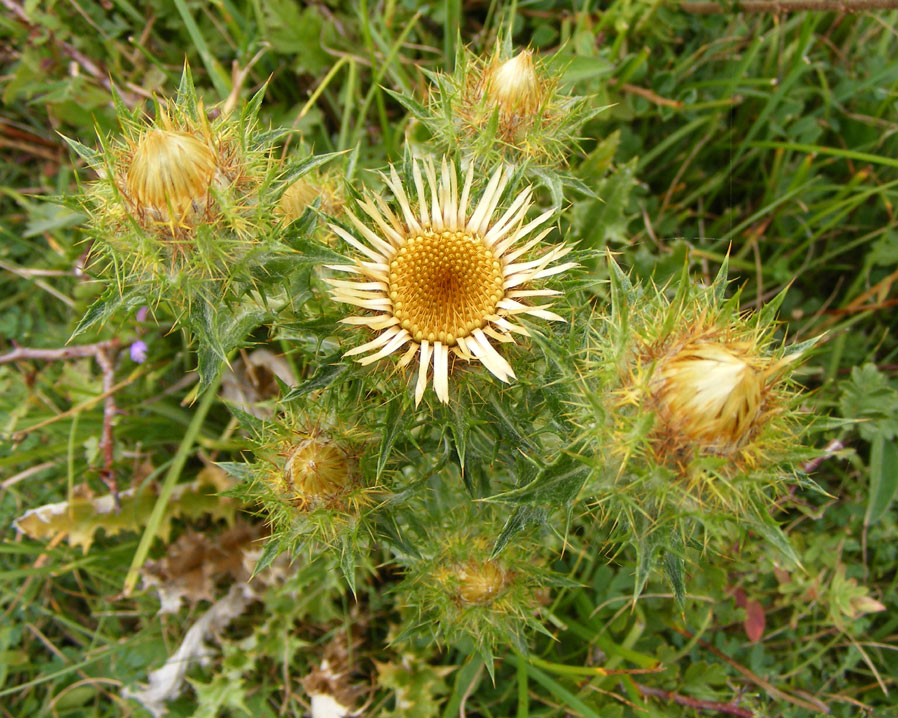 |
|
on Mill Hill |
on Mill Hill |
|
There
were two Speckled Woods
seen on Mill Hill, but there were probably many more as my passage through
the scrub was hurried. White butterflies
were everywhere in small numbers, notably four Green-veined
Whites. Two pristine condition Peacock
Butterflies and three of the smallSmall
Heath Butterflies settled on Mill Hill.
Full
Shoreham Town Wildlife Report
Adur
Butterfly List 2008
1 -
5 August 2008
It
was too breezy and overcast to assess the Chalkhill
Blues on Mill Hill.
30
July 2008
The
Chalkhill
Blues were slow to appear this year, as
the count of a mere 81 (including two females) plus two male Adonis
Blues on the lower
slopes of Mill Hill, indicated. There were a handful of Common
Blues
of both sexes noted on both the lower slopes and upper meadows. I was not
in mood for counting butterflies, but the other butterflies seen on Mill
Hill in the middle of a sunny day were Large
Whites and Speckled
Woods, plus the occasional Marbled
Whites (5), Small
Skippers (3+), Wall
Browns (a courting pair), Peacock
Butterflies (2) and Holly
Blues (2). The usual Gatekeepers
and
Meadow
Browns
were
present everywhere. Six-Spot Burnet Moths
were frequently seen mostly on the upper meadows of Mill Hill. The small
pyralid
moth
Synaphe
punctalis was identified from
the lower slopes.
Full
Butterfly Report
Adur
Burnet Moths
| Hundreds of the small herb Autumn Gentian were poking through the chalky area on the upper plateau of Mill Hill, immediately north of the Reservoir. A handful were in flower for the first time this year. A few Round-headed Rampion were in flower amongst them and only a handful of these blue flowers were seen on a passage trip scattered over the upper hill. | 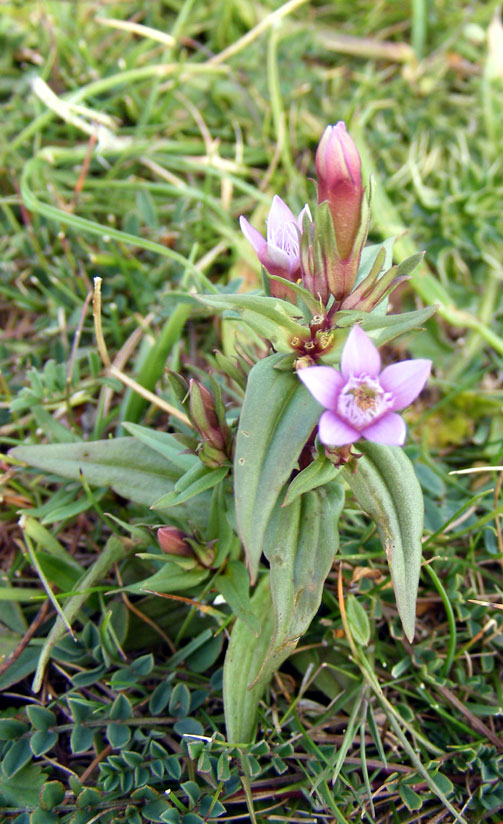 |
 |
28
July 2008
Even
more spectacularly, the number of butterfly
species seen on 27
July 2008 has to be increased by one to 22
species, as a second brood male Adonis
Blue was identified on the lower
slopes of Mill Hill and one was seen there yesterday as well. My visit
was to look for the main emergence of Chalkhill
Blues and make a count on the 1.2 acre
transect of the lower slopes, which came to 68 males. There were also 15+
Chalkhill
Blues on the Mill
Hill Cutting (south-west corner), two seen by the stile to the Old
Erringham pasture, and another six as I returned by the quickest ridge
route through the tunnel of Hawthorn. There were frequent
Gatekeepers
and
Meadow
Browns
everywhere,
with an occasional prevalency
of Speckled Woods
in the shade, plus a Peacock
and at least one Small Heath
on the lower slopes of Mill Hill. A Marbled
White flew amongst the long grass south
of the Reservoir on Mill Hill. On the ridge path a single Marjoram
plant attracted five Gatekeepers
and a Peacock Butterfly.
Six-Spot
Burnet Moths were frequently seen mostly
on the upper meadows of Mill Hill.
Full
Butterfly Report
27
July 2008
On
warm (21.5 °C)
sunny day, an unprecedented 21 species of
butterfly were seen (three more than the previous largest day tally in
the last eight years of 18). Nineteen were seen in two hours in
the morning on Mill Hill and its approaches. However,
only fourteen were seen on Mill Hill proper.
These were Large Whites,
Gatekeepers,
Meadow
Browns
and
Chalkhill
Blues (70),
frequent
Common Blues
(18),
Small Skippers (5),
occasional
Speckled Woods (8), Brown
Argus
(2),
Wall
Brown (3),
Red
Admiral (3), Small
Heath (3), Brimstone
(3), Peacock
(2), and just the one confirmed Green-veined
White. Six-Spot
Burnet Moths were frequently seen mostly
on the upper meadows of Mill Hill.
The
first spectacular Volucella zonaria
hoverfly
of 2008 was seen
amongst the scrub on Mill Hill.
The
first Round-headed Rampion
of the year was noted in flower on the
upper part of Mill Hill.
Full
Butterfly Report
26
July 2008
Several
newly emerged female Wall
had boosted the total to c.15 on Mill Hill
and we watched them ovipositing, locating several of the greenish white,
globular eggs. The second brood Dingy Skipper
was again located, along with the first couple of pristine, second brood
Adonis
Blue.
23
July 2008
Over
200 butterflies of 15 species were seen in
about two hours on Mill Hill and the approaches
with 37 Chalkhill Blues
(including two females)
seen mostly on the lower slopes. Another
notable was the first two of the second brood Brown
Argus
Butterflies in amongst the long grass
and herb meadow north of the upper car park. The Small
White on Mill Hill was confirmed with
a close-up look. Six Peacock Butterflies
were seen.
 |
 |
 |
On
Mill Hill only, Chalkhill
Blues
led the count with 37, Gatekeepers
33,
and
Meadow
Browns
with
17. Large Whites
tallied at eight, Marbled Whites
at seven, Small Skippers
at six, and Wall Browns
at five. I expect the common butterflies
were under-recorded.
The
small herb Autumn Gentian was noted sprouting up on the middle slope
area, but the flowers had not yet appeared.
Tabular
List
Adur
Butterfly List 2008
Full
Report
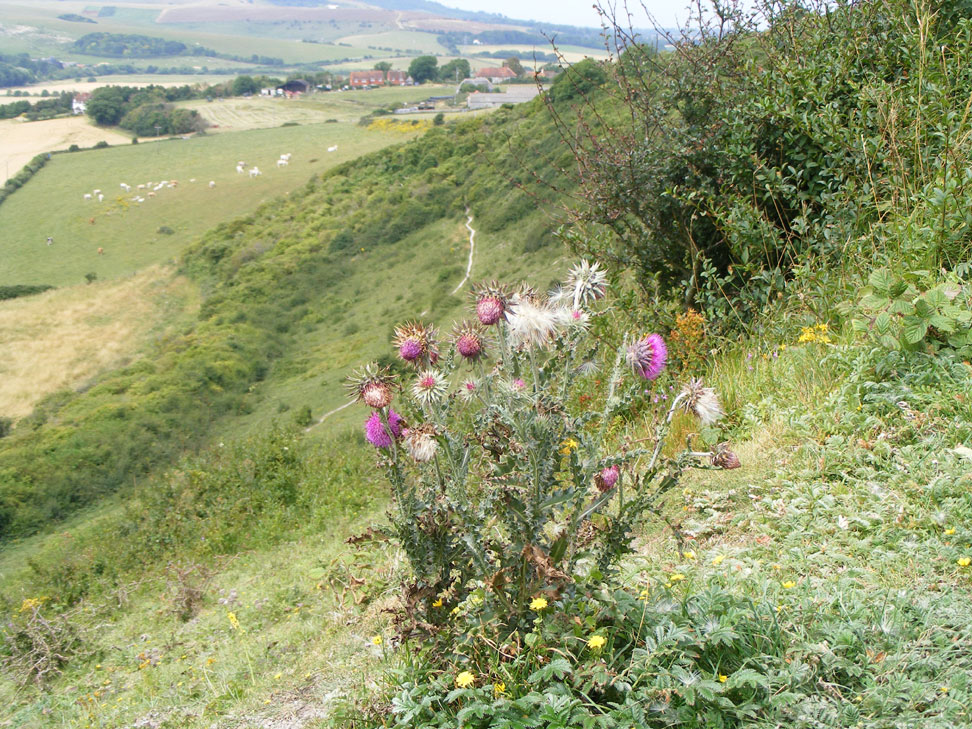 |
 |
Flora
Report
Left: Musk Thistle on the ridge (north-west the Reservoir) overlooking the lower slopes. Right:
|
20
July 2008
Butterflies
are recorded as common (135+) for the first time
this year of 14 species (equal most in a day
this year) of which the most notable was the
first second brood Common Blue Butterfly
on the upper meadow of Mill Hill, three Wall
Browns on Mill Hill and a Chalkhill
Blue count of 17 (including one fresh
female) on an acre of the lower slopes.
Tabular
List
15
July 2008
Chalkhill
Blues were just beginning on Mill Hill
with 24 strong flying males noted. All but one were seen on the lower
slopes and the other one in the Triangle
middle slopes area. Six-spot Burnet Moths
were frequent on the hill, with most in the area to the west of the upper
car park. A Silver Y Moth
was seen on the short grass open plateau. Six Marbled
White Butterflies were recorded and both
Large
Skippers (2) and Small
Skippers (8) in the meadows at the top
of the hill.
Full
Butterfly Report
 |
 |
 |
The
horses
were still present in the field of Ragwort
to
the east of Mill Hill. Contrary to popular
belief Ragwort
is not very dangerous to livestock.
Ragwort
Facts
Chalkhill
Flowers 2008
13
July 2008
The
first female Chalkhill Blue Butterfly
of the year was seen on the lower slopes
of Mill Hill on a drab morning.
The
thin strip of intermittent horse pasture to the east of Mill Hill, (adjacent
and parallel to the A27 dual carriageway
on the northern side), that was covered in swathes of Bird's
Foot Trefoil a month ago
was now dominated by Ragwort
and the Bird's Foot Trefoil
could not be seen from the road.
Full
Butterfly Report
 11
July 2008
11
July 2008
Blustery
conditions (Force 5
gusting to Force 6), but at least the rain
held off: a few butterflies were in flight,
another two Chalkhill Blue Butterflies
flew over the lower slopes of
Mill Hill,
with occasional Gatekeepers,
a Large White,
and two small pyralid
moths,
Pyrausta
nigrata and Pyrausta
despicata.
One of the Chalkhill Blues
settled very briefly on a Self-heal
flower.
Five
species of thistle
were recorded on Mill Hill including the first Stemless
Thistle of the year on the lower slopes,
as well as Spear Thistle, Welted Thistle,
the impressive Musk Thistle
and the ubiquitous Creeping Thistle.
Wild
Basil was noted, but amongst the scrub
rather than on the open slopes.
Adur
Butterfly List 2008
Adur
Thistles
 |
Left:
Stinging Nettles and Spear and Creeping Thistles have now replaced the mixed selection of grasses including Cocksfoot, in the area south of the Reservoir. * Right:
|
 |
* Disturbed and nutrified land where the cattle have grazed.
5 July
2008
A
solitary Swift
flew to and fro over the southern part of Mill Hill.
The
first two Chalkhill Blue Butterflies
flew over the lower slopes of Mill Hill,
late in the afternoon, whilst in a nearby (to the east of Mill
Hill Nature Reserve) field two Horsesgrazed
in a field of long grass and over a hundred Ragwort
plants. It appeared that the two horses were grazing on the grass between
these slightly poisonous plants, but the yellow heads of Ragwort
could be seen moving as the Horses
grazed.
The
first Small Purple-barred Moth, Phytometra
viridaria, of 2008
was seen on the lower slopes, with a probable Ringlet
from the scrub in the north-west of Mill
Hill Nature Reserve which one be (if confirmed)
the first from the Hill and the only one of the 32 species of butterflies
seen in Shoreham that has not been recorded
on the hill. Other butterflies from Mill Hill around 4:30
pm were just the two Small
Heath Butterflies, 14 Marbled
Whites, at least two Large
Whites, ten Meadow
Browns,
one Peacock
Butterfly, seven Gatekeepers,
one Speckled
Wood and
a Green-veined
White on
a passage visit.
Marjoram
was seen in flower in the Triangle
middle slopes area of Mill Hill and this was the first for this year and
the first time I noted this plant on Mill Hill.
Full
Butterfly Report
22
June 2008
The
first grasshoppers were seen and heard on the lower
slopes of Mill Hill, with my first definite sightings of two Marbled
White Butterflies blown about in the Force
6 gusting to Gale
Force 8. One male and one worn female Common
Blue
Butterfly, three Small
Heath Butterflies, and just two Meadow
Brown
Butterflies
were also seen. Welted
Thistle, Musk
Thistle and the ubiquitous Creeping
Thistle were all noted. Squinancywort
was seen in flower for the first time
this year on the lower slopes.
Full
Butterfly Report
19
June 2008
Mill
Hill recorded ten Small Heath Butterflies,
a Large Skipper
on the lower slopes amongst the Brambles
and Tor Grass, four Common Blues
including one female, and four Speckled
Woods amongst the Hawthorn scrub. Agrimony,
Musk
Thistle,
Perforate
St. John's Wort, one Field
Scabious and Common
Centaury
were all recorded in flower
for the first time this year. White Campion
was noted as common beside the paths through the scrub in large clumps.
On the middle slopes, in the Triangle area,
Bird's
Foot Trefoil was flowering in swathes
but not in as large swathes as previous years.
Full
Butterfly Report
8 June
2008
Common
Blue Butterflies (30+) were mating in
the thin strip of intermittent horse pasture to the east of Mill Hill.
There were at least three Small Heath Butterflies
seen on the edge of the swathes of Bird's
Foot Trefoil.
 |
 |
 |
A Broad-bodied
Chaser, Libellula
depressa,
(dragonfly) flew over but it was in silhouette
so its gender was not discerned.
Adur
Butterfly List 2008
6 June
2008
 My
first Large Skipper of
the year looked very fresh and quite lively on the lower
slopes of Mill Hill, but one of the two Dingy
Skippers was very dingy and worn. The
lower slopes produced 16 Adonis Blues
on passage over the transect 1.2 acre
area, including three females, six
Common
Blues
including two females, and two Small Heath
Butterflies with a further one seen
on the upper plateau. Passage through the north-west
Hawthorn scrub area added two Speckled
Wood Butterflies. A further male Adonis
Blue was very easily seen in the Triangle
area of the middle slopes, and a Red Admiral
in the
copse
at the top of Mill Hill. One
Azure
Damselfly,
Coenagrion puella,
was seen on the southern part of Mill Hill. White
Campion was noted as frequently seen in
flower.
My
first Large Skipper of
the year looked very fresh and quite lively on the lower
slopes of Mill Hill, but one of the two Dingy
Skippers was very dingy and worn. The
lower slopes produced 16 Adonis Blues
on passage over the transect 1.2 acre
area, including three females, six
Common
Blues
including two females, and two Small Heath
Butterflies with a further one seen
on the upper plateau. Passage through the north-west
Hawthorn scrub area added two Speckled
Wood Butterflies. A further male Adonis
Blue was very easily seen in the Triangle
area of the middle slopes, and a Red Admiral
in the
copse
at the top of Mill Hill. One
Azure
Damselfly,
Coenagrion puella,
was seen on the southern part of Mill Hill. White
Campion was noted as frequently seen in
flower.
Full
Butterfly Report
Adur
Skippers
Adur
Damsels & Dragonflies
1
June 2008
When
the yellow carpet of Horseshoe Vetch,
Hippocrepis
comosa, was seen to be rapidly fading
on the lower slopes of Mill
Hill, the thin strip of intermittent horse pasture to the east of Mill
Hill, adjacent and parallel to the A27 dual
carriageway on the northern side, was covered
in swathes of Bird's Foot Trefoil covering
a measured 1.5 acres.
Most other flowering herbs were lost amongst the yellow but they included
sparse amounts of
Cut-leaved Cranesbill,
Cleavers,
Fairy Flax, Eyebright, Scarlet Pimpernel
(mostly
on the periphery), White Clover,
Ground
Ivy and
Field
Speedwell.
The
adjacent cattle pasture was devoid of these herbs.
23
Adonis
Blue Butterflies (including just one female
seen) stood out against the green appearance
of the lower slopes, with two Yellow
Shell Moths seen early on amongst the
Wild
Privet, two Small
Heath Butterflies, and one Common
Blue Butterfly. A further Small
Heath Butterfly was spotted as I returned
rapidly by the ridge route. A single Welted
Thistle flower had opened in the scrub
in the north-west of Mill Hill. A large
patch of Silverweed
with at least fifty flowers was noted immediately to the west of the Reservoir
adjacent to the well trodden path winding between the blossoming Elderberry,
and the Hawthorn
that
had ceased flowering. The scrub had been cleared in places and patches
of Stinging Nettles had appeared next to the path.
 |
 |
 |
After
the rain of the last few days, three species of mushroom
have appeared two of them, one a Snowy
Ink Cap, Coprinus
niveus, on the cow pats still remaining
two months after the cattle had been removed from Mill Hill.
The
upper plateau where the cattle had been grazing was noticeably denuded
of both the the swathes of Horseshoe Vetch
and Bird's Foot Trefoil
seen in previous years.
The
characteristic dipping flight of a Yellowhammer
was seen over the lower slopes.
Full
Butterfly Report
Adur
Butterfly List 2008
Full
Wild Flower Report
Adur
Fungi Report
Chalkhill
Fungi of Mill Hill
24
May 2008
Mill
Hill: In windy conditions we managed to see perhaps 30 Adonis
Blue,
including a few females, and three Common
Blues on the lower
slopes along with a couple of Brimstone
Butterflies and a Lesser
Treble-bar Moth. There was also a single
Wall
Brown at the north west corner of the
reserve on the path that leads to Old Erringham Farm.
19
May 2008
 The
characteristic dipping flight of a Yellowhammer
was seen in the distance over the ridge of Mill Hill in slightly cool (12.6
°C) conditions. A 15 minute ramble over
the 1.2 acre transect area of the lower slopes
produced 36 Adonis
Blue
Butterflies
of
which three were females,
six Small Heath Butterflies,
one Dingy Skipper,
three Grizzled Skippers,
one unidentified white butterfly,
one Pyrausta nigrata pyralid
moth,
and two Treble Bar Moths. There
were four Holly Blues
and a few Azure
Damselflies,
Coenagrion
puella, spotted
amongst the scrub in the north-west of Mill
Hill.
The
characteristic dipping flight of a Yellowhammer
was seen in the distance over the ridge of Mill Hill in slightly cool (12.6
°C) conditions. A 15 minute ramble over
the 1.2 acre transect area of the lower slopes
produced 36 Adonis
Blue
Butterflies
of
which three were females,
six Small Heath Butterflies,
one Dingy Skipper,
three Grizzled Skippers,
one unidentified white butterfly,
one Pyrausta nigrata pyralid
moth,
and two Treble Bar Moths. There
were four Holly Blues
and a few Azure
Damselflies,
Coenagrion
puella, spotted
amongst the scrub in the north-west of Mill
Hill.
Elderberry
was
beginning to flower on Mill Hill. An Ink
Cap Mushroom grew out of a cow pat in
the dense herbs and grasses north of the upper car park. On the plateau
south of the upper car park, the Horseshoe
Vetch,
Hippocrepis
comosa, was much less than previous
years, but a patch still occurred at the southern end, just north of the
Reservoir. White Campion
was noticed in flower on the edge of the scrub on the upper parts of the
hill.
Adur
Butterfly List 2008
14
May 2008
A
late afternoon visit to Mill Hill was undertaken for the purpose of ascertaining
the extent of the covering of Horseshoe
Vetch,
Hippocrepis
comosa, which could be seen from Old
Shoreham by the Toll Bridge. It was
at least as spectacular as the best year, but a close inspection revealed
that a proportion (c 5%) of the flowers were already fading on the lower
slopes. The Horseshoe Vetch
was rather sparse on the middle and upper slopes. It is usually later in
these areas, but it still appeared much less than expected. At least
one Bird's Foot Trefoil
was seen. Other flowers noted were the poisonous White
Bryony,
Bryonia
dioica, mostly were the conservation workers had been on Mill Hill,
and the first sign of flowering Hound's
Tongue, Cynoglossum
officinale, notably near the Rabbit
burrows. The invasive Ground Elder, Aegopodium
podagraria, was noted on the upper
part of the hill.
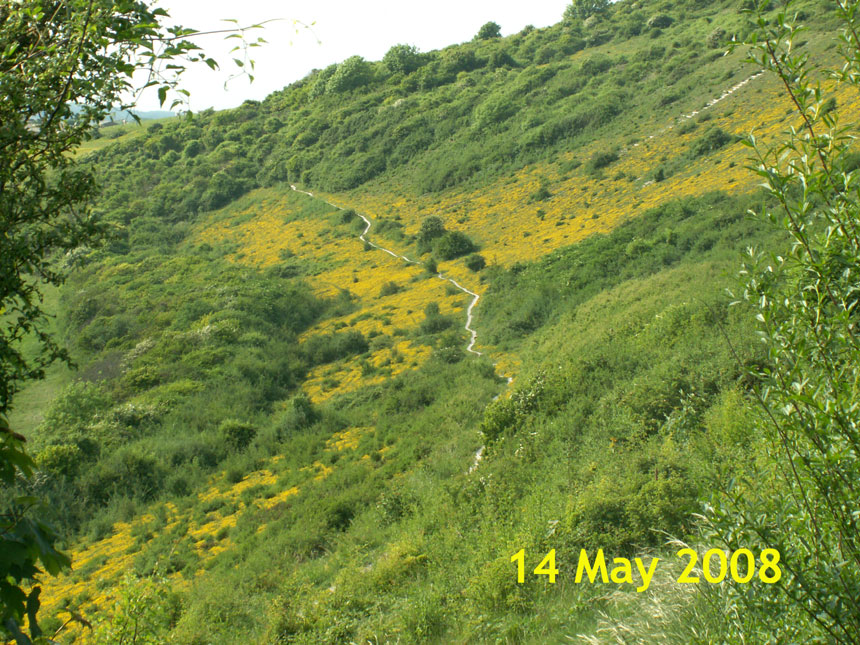 |
 |
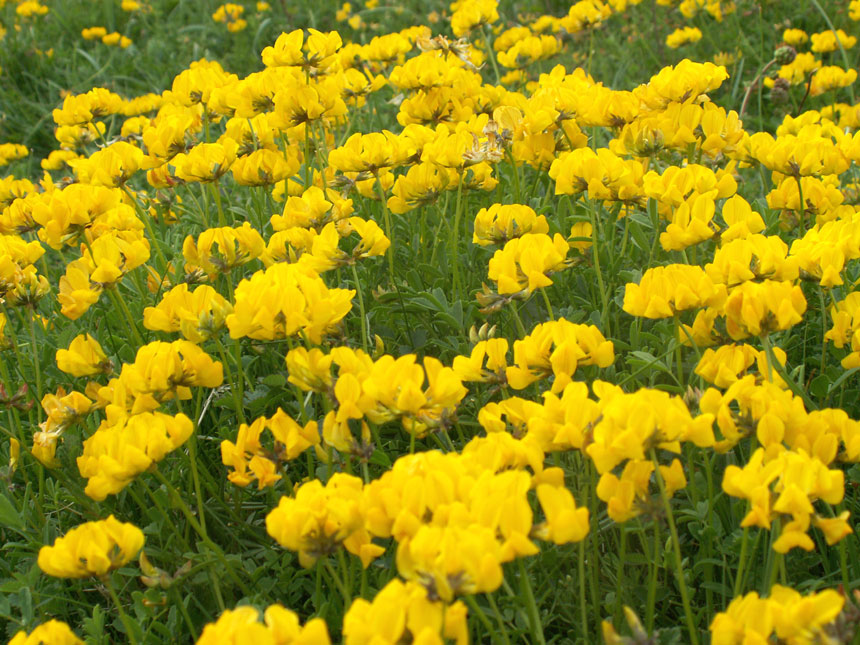 Although,
it was too windy, too cool and too late in the day for butterflies,
a couple of enthusiasts said they had given up counting the Adonis
Blues
at over a hundred over a three acre area of the lower
slopes, and they also had two confirmed Green Hairstreaks on
the middle slopes above the ridge. This hairstreak
is only rarely recorded on Mill Hill. Their species count for Mill Hill
was 14 plus the first Cinnabar
Moth of the year. I recorded my first
definite Common Blue Butterfly*
of the year and my first definite Red Admiral
of 2008.
(*Latterly
rejected as not positive.)
Although,
it was too windy, too cool and too late in the day for butterflies,
a couple of enthusiasts said they had given up counting the Adonis
Blues
at over a hundred over a three acre area of the lower
slopes, and they also had two confirmed Green Hairstreaks on
the middle slopes above the ridge. This hairstreak
is only rarely recorded on Mill Hill. Their species count for Mill Hill
was 14 plus the first Cinnabar
Moth of the year. I recorded my first
definite Common Blue Butterfly*
of the year and my first definite Red Admiral
of 2008.
(*Latterly
rejected as not positive.)
Adur
Butterfly List 2008
Adur
Butterflies: First Dates
9
May 2008
I
was two days late on parade to see my first Adonis
Blue
Butterflies
of
the year on the lower slopes of Mill Hill.
One of the three looked very much like a brown
female
with its wings closed and without the distinctive blue as it flew off.
I also saw five of my first Small Heath
Butterflies
of the year four on the lower
slopes and one on the ridge return route. There was one Wall
Brown, one
male Brimstone Butterfly, one Green-veined
White, eleven Dingy
Skippers and four Grizzled
Skippers. There was a damaged Speckled
Wood Butterfly in the scrub.
 |
 |
 |
|
|
Umbellifers |
|
7 May
2008
While
showing Jack Harrison
(on holiday down here) some of our Sussex sites, I managed to see five
'firsts' for me this year. These were two Adonis
Blue*
(including an atypically early female!), one Common
Blue*, two Small
Heath and three Wall
at Mill Hill. Dingy
and Grizzled Skippers
were plentiful at Mill Hill. (*
first of the year)
6 May
2008
My
first Wall Brown Butterfly
of 2008 and my
first Red Damselfly
were both seen near and in the copse of
Mill Hill. The first Brimstone Butterfly
was a bright yellow male seen over a clearing in the scrub, and then a
bright yellow male and white female appeared to be courting under the canopy
of the copse at the top of Mill Hill, until another yellow male came and
competitively interrupted the proceedings. Whereupon the female disappeared
and the males carried on jousting. Three Holly
Blue Butterflies fluttered around the
low lying scrub on the middle slopes of Mill Hill. The sun was not warm
enough for smallish blue butterflies to open their wings. Two Speckled
Woods danced under the copse at Mill Hill.
11 Grizzled Skippers,
about 12 Dingy
Skippers (one on the middle slopes) and
at least five Pyrausta nigrata pyralid
moths
were seen on the lower slopes.
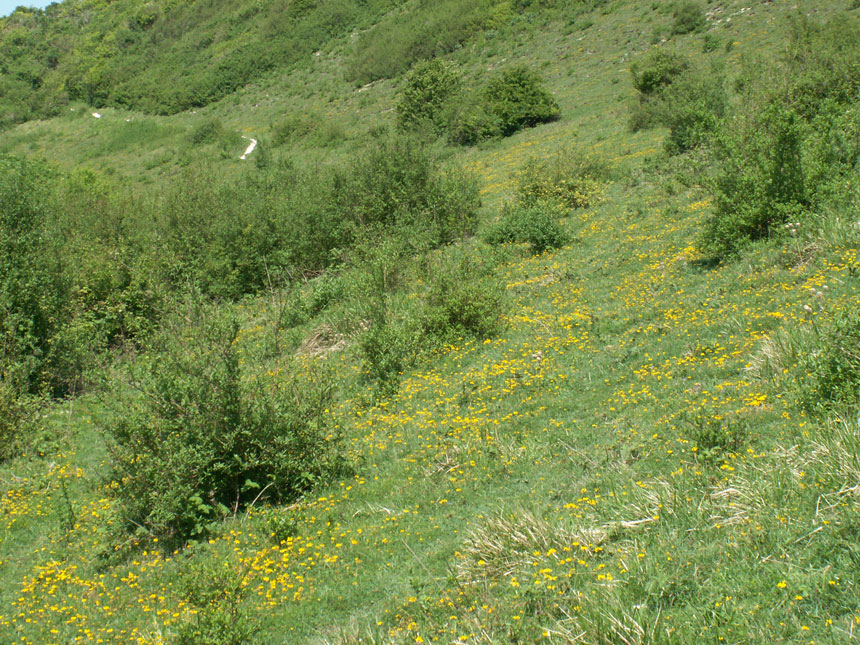 |
 |
 |
|
|
|
|
I also
spotted my first Swallow
of the year on a low level flight so its pale orange belly underside could
be clearly seen.
Horseshoe
Vetch,
Hippocrepis
comosa, was much more prominent on
the lower slopes of Mill Hill and could be seen covering the lower slopes
before I descended the steps at the southern end. Dog
Violets were very common and Milkwort
was
all over the slopes.
A
male Pheasant
was surprised on a path before it trotted off into the Hawthorn scrub of
the north-west.
Adur
Butterflies: First Dates
Adur
Butterfly List 2008
25
April 2008
 The
first
Dingy Skipper
of 2008 was seen
on the lower slopes of Mill Hill around
midday.
One Grizzled Skipper
was also spotted on a passage journey with a return route via the ridge.
Three
Small Tortoiseshells and
a worn Peacock
Butterfly were
recorded on a muggy day. A Rook
flew over.
The
first
Dingy Skipper
of 2008 was seen
on the lower slopes of Mill Hill around
midday.
One Grizzled Skipper
was also spotted on a passage journey with a return route via the ridge.
Three
Small Tortoiseshells and
a worn Peacock
Butterfly were
recorded on a muggy day. A Rook
flew over.
This
small mushroom was discovered on Mill Hill just above the ridge above the
steep lower slopes.
I think this was Stropharia coronilla.
Adur
Fungi 2008
20
April 2008
The
first Green-veined White Butterfly
of the year was seen over the path by the flowering Blackthorn
leading into scrub at the northern end of the lower
slopes of Mill Hill. Two pristine Speckled
Wood Butterflies
were seen above my head
on the Hawthorn in the copse at the top
of Mill Hill. Frequent
Peacock Butterflies
numbered at least a dozen over the lower slopes of Mill Hill.
A
passage journey over the lower slopes of Mill Hill revealed four Grizzled
Skippers visiting Dog
Violets and at least one of the first Pyrausta
nigrata pyralid
moths
of 2008.
13
April 2008
A
Skylark
flew in station above Mill Hill, singing in the warn afternoon after the
midday hail shower.
 |
 |
There were three other butterfly enthusiasts on the lower slopes of Mill Hill in the afternoon, chasing around about ten Grizzled Skippers. Other butterflies recorded on the day on Mill Hill included three Peacocks and one Small Tortoiseshell.
10
April 2008
On
a mild (>10.5 °C)
sunny day there were frequent butterflies on
Mill
Hill and its approaches including my first
Small
Tortoiseshell of the year, the first two
Grizzled
Skippers on the lower
slopes, ten Peacocks
and two Comma Butterflies.
Blackthorn
(=Sloethorn) was in flower, notably south
of the Reservoir.
Adur
Butterflies: First Dates
Adur
Skippers
Adur
Butterfly List 2008
6 April
2008
 |
 |
A surprise
April
snowfall
throughout
the morning (9:00 pm to 12:30 pm)
left snow to a depth of 100+ mm
on Mill Hill, drifting to much deeper in places. Ground Ivy
was seen in flower under the Hawthorn in the north-west
scrub.
Full
Report
Shoreham
Weather Page 2008
5 April
2008
Mill
Hill SMG Meeting
Despite
the awful forecast and plummeting temperature the first SMG evening field
meeting of the year at Mill Hill near Shoreham
was well attended. However, we only saw three moths - but nobody was complaining;
two were of our target species: Barred
Tooth-striped Moth, Trichopteryx
polycommata, and the other
was the micro Pale Flat-body, Agonopterix
pallorella.
26
March 2008
Four
Peacock
Butterflies were seen in under an hour
on the downs north of Shoreham, the first
faded specimen at the top of the Pixie Path
to Mill Hill, the second and third left the lower
slopes of Mill Hill, and the fourth one was in the extreme north-west
corner of Mill Hill Nature Reserve next to
the Old Erringham pasture.
Adur
Butterfly List 2008
9 March 2008
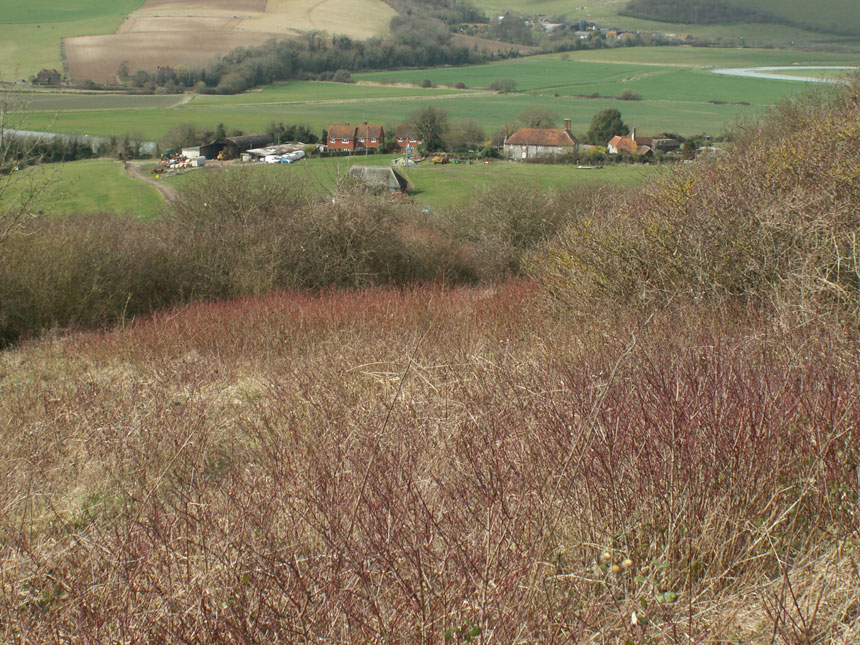
Early growths of Dogwood on the Triangle meadow area on the middle slopes section of Mill Hill, west of the upper car park. Old Erringham Farm is in the background.
27
February 2008
Frequent
Sweet
Violets were now to be seen flowering
on the lower slopes and under the thorn
in the scrub in the north-west corner of
Mill Hill. The cattle now
appear to have been removed, but the hoof prints and dung
were still widespread, and some were fresh.
Adur
Violets
18
February 2008
The
cattle
were
on the flat plateau south of the upper car park. Some of the paths south
of the Reservoir were beginning to be worn from grass to mud by the hoof
prints of the cattle.
There was one cow pat
on the lower slopes and another on the
steep slope below the ridge (part of the lower slopes). There was another
cow
pat on the steps leading down to the lower
slopes which were so muddy that walking boots were advisable.
There
were a few mole hills
seen south of the Reservoir. The mounds of earth were grey.
11
February 2008
A
male Brimstone Butterfly
settled on ivy on wall outside house in Mill Hill Drive, Shoreham at midday.
This
was the first local record of this species for 2008.
11 February 2008
Mill
Hill
viewed
from the Adur Levels, River
Adur estuary, western towpath
10
February 2008
A
handful of Sweet Violets
were in flower at the top of the wooded slopes on the southern section
of Mill Hill.
Around
midday
a Peacock Butterfly rose
from the lower slopes of Mill Hill and
fluttered further up the slope so I had to chase it to identify the good
condition Peacock Butterfly
when it basked briefly in the weak sunshine with its wings open.
This
was the second of two of the first February
records on these Nature Notes pages for the Peacock
Butterfly, making four species seen in the
second month of the year.
Adur
Butterfly Flight Times
Adur
Butterflies: First Dates
Adur
Violets
In perspective, the turf is also broken up by human trampling (as evidenced by the paths) and the burrowing of Rabbits and Moles. The cattle damage is so much more serious because it is unnecessary and the ground is fertilised as well. This fertilisation has a destructive effect on chalkhill flora, allowing common plants to flourish in the richer disturbed conditions. Sheep also cause damage in wet weather but the because of their lighter build if they are stocked at a density of up to one sheep per acre, damage to the chalkhill is acceptable.
The cattle were still trashing the upper plateau area around the car park.
28
January 2008
The
cattle
were now seen from the Adur Levels on
the richer floristic middle zone of Mill Hill, where they will do more
damage.
In
business farming terms, butterfly food plants are weeds to be eradicated.
22
January 2008
The
cattle
were still on Mill Hill dumping their excrement all over the long grass
south of the Reservoir, but also on the recovering herb-rich plateau north
of the Reservoir. Cattle
cause great damage by disturbance of the soil and nutrification with their
urine and faeces. Both these factors change the flora for a long time and
encourage grasses and ruderal plants. A dog
was seen in panic in the presence of the cattle.
Tip:
wear old shoes: the cattle
urinate
on the grass and it can be difficult to get the smell out even if you avoid
the cow pats.
Butterfly
Habitat Notes
4 January
2008
Alas
the cattle
are still trashing the top of Mill Hill in an asinine plan by the Sussex
Downs Conservation Board on an important Nature
Reserve. The flat area being grazed (seen from the Adur Levels) is
an area that contains a recovering low fertility wildlife
meadow flora including Horseshoe Vetch, Hippocrepis
comosa, and many other important caterpillar food plants and nectar
plants. The cattle indiscriminately eat the
flora, but more importantly the destruction occurs because of the ground
disturbance they cause and their patterns of urination and cow pats which
are making the paths impassable on shallow chalk soil in wet muddy conditions.
Chalkhill
herbs require low fertility undisturbed land
and are wiped out (most of them permanently) if the conditions change.
List
of Butterfly Articles
1 January
2008
The
cattle
were not seen on a very muddy Mill Hill. However, there were still cow
pats in annoying places near the road
and on the paths near the Reservoir.
My first wild mammal of 2008 was a Rabbit on the lower slopes of Mill Hill. My first mushroom was a Blewits, Lepista sp., recorded from the ridge of Mill Hill. I originally identified this as a Field Blewits, Lepista saeva, but this species has no blue on its cap. There was no flowers to be seen on the lower slopes except for the silver leaved Carline Thistle heads. It is never quite clear with this plant as the flower heads last longer and the petals do not fall off.
I'd
go for the rather variable Lepista
sordida for this mushroom, but
you really need to measure the spores to be sure. Lepista
sordida is the only Lepista
which
can be completely blue/purple all over, but it can also have hardly any
blue at all. It favours disturbed and garden situations (probably slightly
raised fertility but overlaps in this with Wood Blewits)
Lepista
saeva doesn't have any blue/purple in the cap.
20
December 2007
The
South
Downs Conservation Board reintroduce cattle
gazing with a few beef cattle on the upper slopes of Mill Hill. This
is detrimental to the chalkhill flora,
possibly serious damaging and confers no advantages. The cattle were seen
from the Adur valley.
Previous
Incidence
List
of Butterfly Articles
Mill
Hill Wildlife Reports 2007 (Link)
LINK TO THE WILDLIFE REPORTS FOR AUTUMN - SUMMER 2004
LINK TO THE MILL HILL WILDLIFE REPORTS FOR WINTER & SPRING 2004
| Chalkhill
Blue (3000 +)
Adonis Blue (50 -100) Dingy Skipper (75) |
Small
Heath (250)
Wall Brown (12) Meadow Brown (300) |
Marbled White (50)
Gatekeeper (200) Speckled Wood (>50) Green-veined White (2+) |
Common
Blue (>4000+)
Small Blue (5) Brimstone (8) |
Small
Skipper (>50)
Large Skipper (10+) Grizzled Skipper (20) Brown Argus (>30) |
The other species may breed on Mill Hill, but there main breeding area will be adjoining fields or slightly further away. e.g. Small Blue (included above), Small Copper, Small Tortoiseshell, Green-veined White, Peacock, Ringlet, Small White, Large White, Comma, Holly Blue, Orange Tip. (=10)
The following are immigrants &/or hibernators: Red Admiral, Painted Lady, Clouded Yellow.
The following have not been positively identified (because of ID difficulties): Essex Skipper. This species is now included for a local field on the Adur Levels within 500 metres of Mill Hill.
(=30)
The
following may (probably does) occur but it has not been positively identified
(because it is elusive and hard to spot): Green
Hairstreak.
(=31?)
The next one is no longer
found on Mill Hill but were there in the recent (reduced drastically to
almost extinct by 1948 last record in 1968) past: Dark
Green Fritillary (Records of this butterfly
in 1857, 1938, and 1945 when it was common.)
The next one is no longer
found on Mill Hill but were there in the distant (1947) past: Grayling.
The next one has been recorded
near Mill Hill in the middle distance past: White-letter
Hairstreak
(=34)
The
Silver-spotted
Skipper does not appear to ever have occurred
on Mill Hill
The
Silver-studded
Blue has never been recorded from Mill Hill
The
Short-tailed
Blue was recorded as a single immigrant in
1956.
Aerial
Map
Lower
Adur Levels (MultiMap) including Lancing Clump and Mill Hill
Horseshoe
Vetch,
Hippocrepis comosa
First
Draft of the Article for the Shoreham Society Newsletter